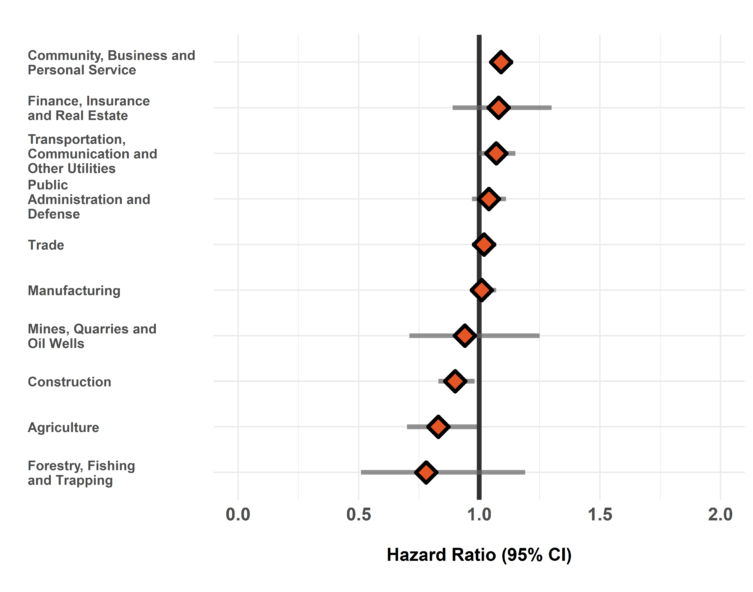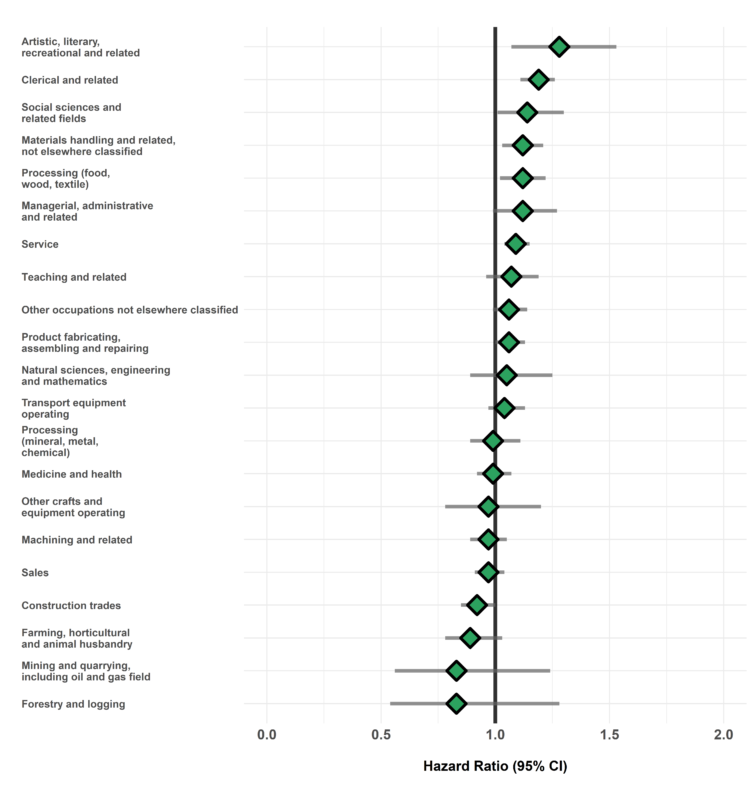Asthma
Background
Asthma is a common inflammatory disease of the respiratory system, often due to allergens and irritants [1]. Asthma is also the most common work-related respiratory condition with an estimated 15% of cases of adult asthma arising due to workplace exposures [2]. There are numerous occupational risk factors for this condition and workers across many occupations and industries are at risk.
Occupational risk factors
-
- Isocyanates [3]
- Dusts (metal, wood, grain/flour, animal, etc.) [3,4]
- Latex [3]
- Acid anhydrides [3]
- Cleaning products [4]
- Metalworking fluids [3]
- Exhaust fumes [3]
- Other chemical irritants
Key Findings
The greatest risks of asthma were observed among painters, bakers, cabinet and wood furniture makers, and concrete finishers. The ODSS tracked new-onset adult asthma, but workplace exposures can also exacerbate asthma among workers with a previous diagnosis.
Painters
 Workers employed as ‘painters and decorators’ includes workers that use spray equipment to apply paint to products, materials and other surfaces including motor vehicles. Automotive spray painters have known exposure to paints and coatings containing isocyanates, a well-established risk factor for asthma [2,5]. Painters in construction may more frequently work with paints that lack isocyanates, which may explain this difference in observed risk [6].
Workers employed as ‘painters and decorators’ includes workers that use spray equipment to apply paint to products, materials and other surfaces including motor vehicles. Automotive spray painters have known exposure to paints and coatings containing isocyanates, a well-established risk factor for asthma [2,5]. Painters in construction may more frequently work with paints that lack isocyanates, which may explain this difference in observed risk [6].
-
- Painters and decorators, except construction: 1.54 times the risk
- Painters and paperhangers (construction): 0.82 times the risk
Bakers
 Bakers and confectionary makers are at an increased risk of asthma, likely due to exposure to grain and flour dust.
Bakers and confectionary makers are at an increased risk of asthma, likely due to exposure to grain and flour dust.
-
- Bakers and confectionary makers: 1.62 times the risk
Construction
 Within the construction sector, concrete finishers showed an increased risk of asthma. These workers may be exposed to substances like inorganic dusts, such as silica, which may be respiratory irritants and induce asthma.
Within the construction sector, concrete finishers showed an increased risk of asthma. These workers may be exposed to substances like inorganic dusts, such as silica, which may be respiratory irritants and induce asthma.
-
- Concrete finishers and related workers: 2.03 times the risk
Woodwork
 Cabinet and wood furniture makers are exposed to wood dust, a well-established risk factor for asthma. However, some other wood and wood processing occupations tracked by the ODSS did not have an increased risk of asthma, including carpenters, sawmill workers, and wood machinists. Although there is a well-recognized increased risk of asthma among woodworkers, risks may be specific to certain wood species and could also be influenced by additional factors such as the wood particle sizes generated during different tasks [7,8].
Cabinet and wood furniture makers are exposed to wood dust, a well-established risk factor for asthma. However, some other wood and wood processing occupations tracked by the ODSS did not have an increased risk of asthma, including carpenters, sawmill workers, and wood machinists. Although there is a well-recognized increased risk of asthma among woodworkers, risks may be specific to certain wood species and could also be influenced by additional factors such as the wood particle sizes generated during different tasks [7,8].
-
- Cabinet and wood furniture makers: 1.27 times the risk
- Carpenters: 0.79 times the risk
Janitors and cleaners
 Janitors and cleaners may have increased risks of asthma due to exposure to cleaning agents, disinfectants, detergents, and dusts [3].
Janitors and cleaners may have increased risks of asthma due to exposure to cleaning agents, disinfectants, detergents, and dusts [3].
-
- Janitors and cleaners: 1.10 times the risk
Workers in medicine and health
 Increased rates of asthma among healthcare workers have been previously observed and linked to the use of natural rubber latex gloves and other products. In the ODSS, most healthcare worker subgroups showed decreased risks of asthma. The introduction of low-powder or low-protein content and non-latex gloves in the late 1990s before the timeframe of the asthma analyses in the ODSS could partially explain this finding [3]. Healthcare workers may still have other relevant exposures, including cleaning products, but risks may vary by cleaning agent or tasks [9,10].
Increased rates of asthma among healthcare workers have been previously observed and linked to the use of natural rubber latex gloves and other products. In the ODSS, most healthcare worker subgroups showed decreased risks of asthma. The introduction of low-powder or low-protein content and non-latex gloves in the late 1990s before the timeframe of the asthma analyses in the ODSS could partially explain this finding [3]. Healthcare workers may still have other relevant exposures, including cleaning products, but risks may vary by cleaning agent or tasks [9,10].
-
- Other occupations in medicine and health, not elsewhere classified*: 1.42 times the risk
- Nurses, graduate, except supervisors: 0.92 times the risk
- Nursing, therapy and related assisting occupations, not elsewhere classified**: 0.75 times the risk
*This group includes occupations involved in controlling infection and assisting professional staff in clinics, pharmacies, morgues, and animal hospitals, and sterilizing and packaging hospital supplies, among others.
**This group includes occupations involved in assisting surgical teams before and during surgical procedures; providing art, dance, music, recreational and other therapy programs; providing supportive services in diagnostic and therapeutic procedures; and assisting as members of an ambulance team.
Relative Risk by Industry and Occupation
Figure 1. Risk of asthma diagnosis among workers employed in each industry group relative to all others, Occupational Disease Surveillance System (ODSS), 1999-2016

The hazard ratio is an estimate of the average time to diagnosis among workers in each industry/occupation group divided by that in all others during the study period. Hazard ratios above 1.00 indicate a greater risk of disease in a given group compared to all others. Estimates are adjusted for birth year and sex. The width of the 95% Confidence Interval (CI) is based on the number of cases in each group (more cases narrows the interval).
Figure 2. Risk of asthma diagnosis among workers employed in each occupation group relative to all others, Occupational Disease Surveillance System (ODSS), 1999-2016

The hazard ratio is an estimate of the average time to diagnosis among workers in each industry/occupation group divided by that in all others during the study period. Hazard ratios above 1.00 indicate a greater risk of disease in a given group compared to all others. Estimates are adjusted for birth year and sex. The width of the 95% Confidence Interval (CI) is based on the number of cases in each group (more cases narrows the interval).
Table of Results
Table 1. Surveillance of Asthma: Number of cases, workers employed, and hazard ratios in each industry (SIC)
| SIC Code * | Industry Group | Number of cases | Number of workers employed | Hazard Ratio (95% CI) † |
| 1 | Agriculture | 123 | 10,456 | 0.83 (0.70-0.99) |
| 2/3 | Forestry, Fishing and Trapping | 22 | 2,175 | 0.78 (0.51-1.19) |
| 4 | Mines, Quarries and Oil Wells | 48 | 4,175 | 0.94 (0.71-1.25) |
| 5 | Manufacturing | 2,296 | 155,261 | 1.01 (0.97-1.07) |
| 6 | Construction | 702 | 63,129 | 0.90 (0.83-0.98) |
| 7 | Transportation, Communication and Other Utilities | 878 | 61,586 | 1.07 (1.00-1.15) |
| 8 | Trade | 2,068 | 135,413 | 1.02 (0.97-1.07) |
| 9 | Finance, Insurance and Real Estate | 110 | 6,856 | 1.08 (0.89-1.30) |
| 10 | Community, Business and Personal Service | 3,511 | 197,453 | 1.09 (1.05-1.14) |
| 11 | Public Administration and Defense | 892 | 56,914 | 1.04 (0.97-1.11) |
| * SIC: Standard Industrial Classification (1970) | ||||
| † Hazard ratio in each group relative to all others | ||||
Table 2. Surveillance of Asthma: Number of cases, workers employed, and hazard ratios in each occupation (CCDO) group
| CCDO Code * | Occupation Group | Number of cases | Number of workers employed | Hazard Ratio (95% CI) † |
| 11 | Managerial, administrative and related |
244 | 13,685 | 1.12 (0.99-1.27) |
| 21 | Natural sciences, engineering and mathematics |
134 | 9,283 | 1.05 (0.89-1.25) |
| 23 | Social sciences and related fields |
252 | 12,125 | 1.14 (1.01-1.30) |
| 25 | Religion | <5 | 44 | – |
| 27 | Teaching and related | 355 | 18,530 | 1.07 (0.96-1.19) |
| 31 | Medicine and health | 883 | 46,541 | 0.99 (0.92-1.07) |
| 33 | Artistic, literary, recreational and related |
124 | 6,200 | 1.28 (1.07-1.53) |
| 41 | Clerical and related | 1,143 | 59,336 | 1.19 (1.11-1.26) |
| 51 | Sales | 907 | 56,363 | 0.97 (0.91-1.04) |
| 61 | Service | 1,970 | 113,403 | 1.09 (1.04-1.15) |
| 71 | Farming, horticultural and animal husbandry |
199 | 16,118 | 0.89 (0.78-1.03) |
| 73 | Fishing, hunting, trapping and related |
<5 | 167 | — |
| 75 | Forestry and logging | 21 | 1,939 | 0.83 (0.54-1.28) |
| 77 | Mining and quarrying, including oil and gas field |
24 | 2,427 | 0.83 (0.56-1.24) |
| 81 | Processing (mineral, metal, chemical) |
322 | 22,229 | 0.99 (0.89-1.11) |
| 82 | Processing (food, wood, textile) |
498 | 28,569 | 1.12 (1.02-1.22) |
| 83 | Machining and related | 631 | 48,057 | 0.97 (0.89-1.05) |
| 85 | Product fabricating, assembling and repairing |
1,178 | 80,429 | 1.06 (1.00-1.13) |
| 87 | Construction trades | 690 | 61,720 | 0.92 (0.85-1.00) |
| 91 | Transport equipment operating |
701 | 53,575 | 1.04 (0.97-1.13) |
| 93 | Materials handling and related, not elsewhere classified |
634 | 41,469 | 1.12 (1.03-1.21) |
| 95 | Other crafts and equipment operating |
84 | 6,166 | 0.97 (0.78-1.20) |
| 99 | Other occupations not elsewhere classified | 911 | 60,761 | 1.06 (0.99-1.14) |
| * CCDO: Canadian Classification Dictionary of Occupations (1971) | ||||
| † Hazard rate in each group relative to all others | ||||
Please note that ODSS results shown here may differ from those previously published or presented. This may occur due to changes in case definitions, methodological approaches, and the ongoing nature of the surveillance cohort.
References
- Statistics Canada. Table 13-10-0096-01: Health characteristics, annual estimates. 2020.
- Balmes J, Becklake M, Blanc P, Henneberger P, Kreiss K, Mapp C, et al. American Thoracic Society Statement: Occupational contribution to the burden of airway disease. Am J Respir Crit Care Med. 2003;167(5):787–97.
- Vandenplas O. Occupational Asthma: Etiologies and Risk Factors. Allergy Asthma Immunol Res. 2011;3(3):157–67.
- Tarlo SM, Lemiere C. Occupational asthma. N Engl J Med. 2014;370(7):640–9.
- Kogevinas M, Antó JM, Sunyer J, Tobias A, Kromhout H, Burney P, and the European Community Respiratory Health Survey Study Group. Occupational asthma in Europe and other industrialised areas: A population-based study. Lancet. 1999;353(9166):1750–4.
- Kaukiainen A, Martikainen R, Riala R, Reijula K, Tammilehto L. Work tasks, chemical exposure and respiratory health in construction painting. Am J Ind Med. 2008;51(1):1–8.
- Wiggans RE, Evans G, Fishwick D, Barber CM. Asthma in furniture and wood processing workers: A systematic review. Occup Med. 2016;66(3):193–201.
- Heikkilä P, Martikainen R, Kurppa K, Husgafvel-Pursiainen K, Karjalainen A. Asthma incidence in wood-processing industries in Finland in a register-based population study. Scand J Work Environ Health. 2008;34(1):66–72.
- Liss GM, Buyantseva L, Luce CE, Ribeiro M, Manno M, Tarlo SM. Work-related asthma in health care in Ontario. Am J Ind Med. 2011;54(4):278–84.
- Dumas O, Donnay C, Heederik DJJ, Héry M, Choudat D, Kauffmann F, Le Moual N. Occupational exposure to cleaning products and asthma in hospital workers. Occup Environ Med. 2012;69(12):883–9.
